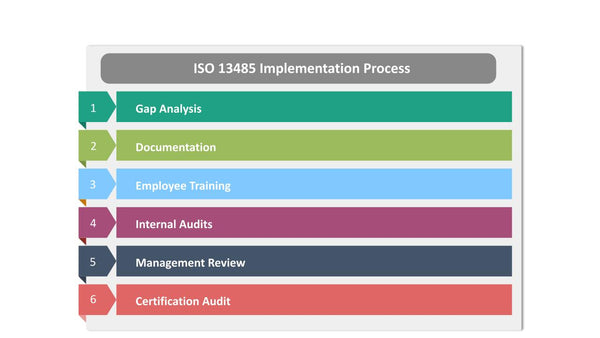ISO 13485: Ensuring Quality in the Medical Device Industry
In the ever-evolving landscape of healthcare and medical technology, quality is paramount. Ensuring the safety and efficacy of medical devices is a critical concern, both for manufacturers and the patients who rely on these products. ISO 13485 is a globally recognized standard that sets the benchmark for quality management systems in the medical device industry. In this blog post, we will delve deep into ISO 13485, its significance, key components, benefits, and how it contributes to the overall quality and safety of medical devices.
Understanding ISO 13485
ISO 13485 is an international standard specifically tailored for the medical device industry. It provides a comprehensive framework for establishing and maintaining a quality management system (QMS) that meets regulatory requirements and ensures the consistent delivery of safe and effective medical devices. This standard is applicable to a wide range of organizations, from manufacturers of complex medical equipment to producers of disposable medical supplies.
ISO 13485 is rooted in the ISO 9001 framework but includes additional requirements specific to medical devices. It emphasizes risk management, regulatory compliance, and traceability throughout the product life cycle.

Key Components of ISO 13485
To achieve compliance with ISO 13485, organizations must adhere to several key components. These include:
- Management Responsibility: Top management's commitment to quality is crucial. They must establish quality policies, objectives, and a framework for the QMS. This commitment sets the tone for the entire organization.
- Resource Management: Adequate resources, including personnel and infrastructure, must be allocated to maintain and improve the QMS. This ensures that the organization can effectively implement and sustain its quality processes.
- Product Realization: This section covers the entire product lifecycle, from design and development to production, installation, and servicing. It outlines the processes and controls necessary to bring safe and effective medical devices to market.
- Measurement, Analysis, and Improvement: Continuous monitoring and improvement of processes and product quality are essential. This involves data collection, analysis, and the use of corrective and preventive actions to address issues and drive improvements.
Benefits of ISO 13485
Implementing ISO 13485 can yield numerous benefits for organizations in the medical device industry. These advantages include:
- Regulatory Compliance: ISO 13485 helps companies align with global regulatory requirements, reducing the risk of non-compliance and associated penalties. It ensures that products meet the necessary safety and quality standards for market approval.
- Enhanced Product Quality: A robust QMS ensures that medical devices meet or exceed quality standards, enhancing patient safety and satisfaction. High-quality products reduce the risk of recalls and product failures.
- Improved Efficiency: Streamlined processes and reduced errors lead to increased operational efficiency and cost savings. Fewer errors mean fewer resources are wasted on reworking or addressing customer complaints.
- International Market Access: ISO 13485 certification is often a requirement for entering global markets, and expanding the potential customer base. Certification demonstrates a commitment to quality and compliance, which can be a competitive advantage.
ISO 13485 vs. ISO 9001
ISO 13485 and ISO 9001 are both quality management system standards, but they serve different industries and purposes.
ISO 13485 is tailored specifically for the medical device industry, emphasizing regulatory compliance, risk management, and traceability throughout the product lifecycle. It ensures that medical devices meet stringent safety and efficacy requirements, making it crucial for patient safety.
ISO 9001, on the other hand, is a more general quality management standard applicable to various industries. It focuses on customer satisfaction, process improvement, and meeting customer requirements. ISO 9001 promotes quality and efficiency across organizations but lacks the industry-specific focus and regulatory rigor of ISO 13485.

ISO 13485 Implementation Process
Implementing ISO 13485 involves several steps, including gap analysis, documentation, employee training, and audits. We'll delve into each phase and provide tips for a smooth transition to compliance.
- Gap Analysis: Begin by assessing your current processes and documentation against the ISO 13485 requirements. Identify areas where you fall short and create an action plan to address these gaps.
- Documentation: Develop the necessary quality management system documentation, including quality manuals, procedures, work instructions, and forms. Ensure that documentation aligns with ISO 13485 requirements and is accessible to employees.
- Employee Training: Provide training to employees on ISO 13485 requirements and how they relate to their roles. This helps ensure that everyone understands their responsibilities in maintaining the QMS.
- Internal Audits: Conduct internal audits to assess the effectiveness of your QMS. Identify non-conformities and take corrective actions to address them.
- Management Review: Top management should review the QMS periodically to ensure its continued suitability, adequacy, and effectiveness. Make necessary improvements based on the review findings.
- Certification Audit: Engage a certification body to conduct an external audit. If your organization meets the ISO 13485 requirements, you will receive certification.
Conclusion
ISO 13485 plays a pivotal role in ensuring the quality, safety, and efficacy of medical devices. Its global recognition, comprehensive framework, and the myriad benefits it offers make it an indispensable standard for organizations in the medical device industry. By adhering to ISO 13485, companies not only meet regulatory requirements but also gain a competitive edge in a highly demanding and critical sector.
This comprehensive blog post provides an in-depth understanding of ISO 13485, empowering organizations to embark on their journey toward quality excellence in the medical device industry. It underscores the importance of a robust quality management system in safeguarding patient well-being and maintaining the integrity of the medical device market.

